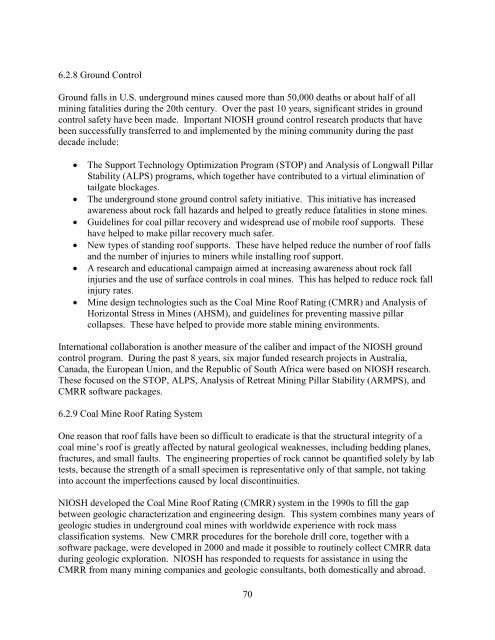One Hundred Years of Federal Mining Safety and Health Research
One Hundred Years of Federal Mining Safety and Health Research
One Hundred Years of Federal Mining Safety and Health Research
- No tags were found...
You also want an ePaper? Increase the reach of your titles
YUMPU automatically turns print PDFs into web optimized ePapers that Google loves.
6.2.8 Ground Control<br />
Ground falls in U.S. underground mines caused more than 50,000 deaths or about half <strong>of</strong> all<br />
mining fatalities during the 20th century. Over the past 10 years, significant strides in ground<br />
control safety have been made. Important NIOSH ground control research products that have<br />
been successfully transferred to <strong>and</strong> implemented by the mining community during the past<br />
decade include:<br />
• The Support Technology Optimization Program (STOP) <strong>and</strong> Analysis <strong>of</strong> Longwall Pillar<br />
Stability (ALPS) programs, which together have contributed to a virtual elimination <strong>of</strong><br />
tailgate blockages.<br />
• The underground stone ground control safety initiative. This initiative has increased<br />
awareness about rock fall hazards <strong>and</strong> helped to greatly reduce fatalities in stone mines.<br />
• Guidelines for coal pillar recovery <strong>and</strong> widespread use <strong>of</strong> mobile ro<strong>of</strong> supports. These<br />
have helped to make pillar recovery much safer.<br />
• New types <strong>of</strong> st<strong>and</strong>ing ro<strong>of</strong> supports. These have helped reduce the number <strong>of</strong> ro<strong>of</strong> falls<br />
<strong>and</strong> the number <strong>of</strong> injuries to miners while installing ro<strong>of</strong> support.<br />
• A research <strong>and</strong> educational campaign aimed at increasing awareness about rock fall<br />
injuries <strong>and</strong> the use <strong>of</strong> surface controls in coal mines. This has helped to reduce rock fall<br />
injury rates.<br />
• Mine design technologies such as the Coal Mine Ro<strong>of</strong> Rating (CMRR) <strong>and</strong> Analysis <strong>of</strong><br />
Horizontal Stress in Mines (AHSM), <strong>and</strong> guidelines for preventing massive pillar<br />
collapses. These have helped to provide more stable mining environments.<br />
International collaboration is another measure <strong>of</strong> the caliber <strong>and</strong> impact <strong>of</strong> the NIOSH ground<br />
control program. During the past 8 years, six major funded research projects in Australia,<br />
Canada, the European Union, <strong>and</strong> the Republic <strong>of</strong> South Africa were based on NIOSH research.<br />
These focused on the STOP, ALPS, Analysis <strong>of</strong> Retreat <strong>Mining</strong> Pillar Stability (ARMPS), <strong>and</strong><br />
CMRR s<strong>of</strong>tware packages.<br />
6.2.9 Coal Mine Ro<strong>of</strong> Rating System<br />
<strong>One</strong> reason that ro<strong>of</strong> falls have been so difficult to eradicate is that the structural integrity <strong>of</strong> a<br />
coal mine’s ro<strong>of</strong> is greatly affected by natural geological weaknesses, including bedding planes,<br />
fractures, <strong>and</strong> small faults. The engineering properties <strong>of</strong> rock cannot be quantified solely by lab<br />
tests, because the strength <strong>of</strong> a small specimen is representative only <strong>of</strong> that sample, not taking<br />
into account the imperfections caused by local discontinuities.<br />
NIOSH developed the Coal Mine Ro<strong>of</strong> Rating (CMRR) system in the 1990s to fill the gap<br />
between geologic characterization <strong>and</strong> engineering design. This system combines many years <strong>of</strong><br />
geologic studies in underground coal mines with worldwide experience with rock mass<br />
classification systems. New CMRR procedures for the borehole drill core, together with a<br />
s<strong>of</strong>tware package, were developed in 2000 <strong>and</strong> made it possible to routinely collect CMRR data<br />
during geologic exploration. NIOSH has responded to requests for assistance in using the<br />
CMRR from many mining companies <strong>and</strong> geologic consultants, both domestically <strong>and</strong> abroad.<br />
70
















